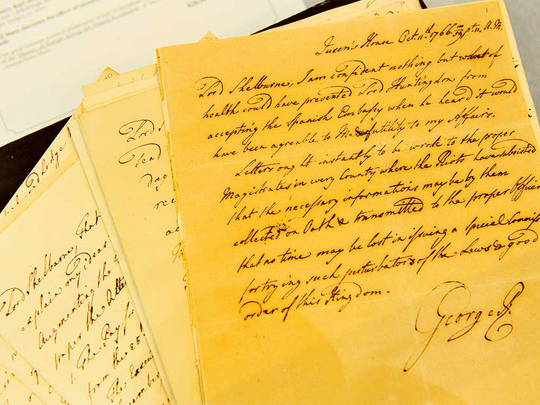
London: Thousands of papers from the reign of Britain’s King George III went online on Saturday, including an essay by the monarch on losing America and details of his spy network.
Some 33,000 pages were published by the Royal Archives, detailing the life and times of Britain’s longest-reigning king, who was on the throne from 1760 to 1820.
“George III is often labelled as ‘mad’, or the king who lost America,” said the Georgian Papers Programme.
The papers bring new insights into a “complex, engaged polymath and highly informed monarch”, it said.
Oliver Urquhart Irvine, the Royal Archives librarian, said the new database, which has the support of Queen Elizabeth II, would open up the historic papers to a global audience.
“Seeing original documents is utterly compelling,” he said. “You can feel the passion, personality, worries and triumphs of individuals who have shaped major events. It can change your perspective of history.”
It was during King George’s reign that Britain lost the Thirteen Colonies, which declared independence as the United States in 1776 — a moment lamented by the sovereign in an essay which is part of the digitised collection.
“America is lost!” the king writes, in a text which archivists have said is a near verbatim extract from a longer essay published by a different author.
A turning point in the US independence campaign — the 1781 Battle of the Chesapeake — is captured in a paper written by naval officer Samuel Hood.
“The king takes his job very seriously. He is processing knowledge on a proto-industrial scale as a part of his role,” said Andrew Lambert, professor of naval history at King’s College London.
“He’s the best-informed chief executive this country has ever had.”
The papers are accompanied by a BBC documentary, “George III — The Genius of the Mad King”.
The newly published archive includes instructions to the 18th-century explorer James Cook and details of King George’s spy network.
In one document, a spy with the code name Aristarchus asks for payment for warning of a French assassination plot against the king.
Personal correspondence is also in the archive, such as a letter sent by queen Charlotte after the death of her young son prince Alfred, which included a lock of the toddler’s hair.
Although King George was on the throne until 1820, his eldest son reigned as regent from 1811 because of recurrent, and eventually permanent, mental illness.
An insight into the formal handover of power is given with two pages detailing the banquet for King George IV’s coronation, in 1821.
The menu fit for the king includes “La Blanquette de Poulardes aux truffes de France” (chicken in white sauce with French truffles), served in Westminster Hall.
Publication of the royal papers is set to continue, with more than 350,000 pages set to be added to the Georgian Papers Programme database by 2020.
They cover the reigns of Britain’s first four kings called George, from 1714 to 1837.
For more than a century the papers have been stored in the Round Tower of Windsor Castle, a royal residence west of London.











